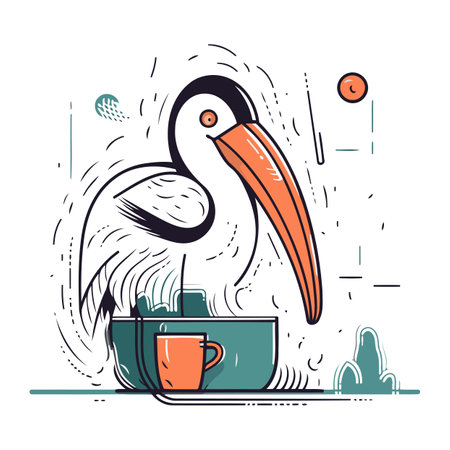Introduction to Coffee Art in India
In recent years, India has witnessed a fascinating transformation in its coffee culture, especially with the rise of coffee art. Traditionally known for its chai and strong filter coffee, the country is now embracing espresso-based drinks and the visually captivating world of latte art. Indian artists and baristas are blending their rich heritage with contemporary brewing techniques, resulting in coffee art that is deeply inspired by local myths and folktales. From intricate rangoli-inspired designs to motifs drawn from epic tales like the Ramayana and Mahabharata, these creations are more than just surface-level beauty—they represent a fusion of age-old storytelling with the modern café experience. As coffee shops flourish from Bengaluru to Mumbai, the growing appreciation for both taste and aesthetics signals how India’s vibrant traditions are being poured into every cup, making each sip a unique cultural journey.
2. Mythological Inspirations: Gods and Folktales in Latte Art
India’s vast tapestry of myths, gods, and epic tales has long influenced its art forms, and today, this cultural richness finds a new canvas—coffee. Indian baristas are now drawing inspiration from legendary figures and stories such as Lord Ganesha, Krishna, and motifs from the Ramayana and Mahabharata to create intricate latte and foam art that resonates deeply with local coffee lovers.
Iconic Deities as Coffee Art Muses
From the gentle curves of Ganesha’s trunk to the peacock feathers of Krishna, each design is both a tribute to spiritual tradition and a testament to the steady hands of India’s emerging coffee artists. For many, seeing a familiar god or story symbol atop their morning cappuccino is more than just aesthetic pleasure—it becomes a moment of connection with heritage.
Popular Mythological Motifs in Coffee Art
| Mythological Figure/Epic | Symbol/Element Used | Cultural Significance |
|---|---|---|
| Lord Ganesha | Elephant Head, Modak (sweet) | Remover of obstacles; brings good fortune |
| Krishna | Flute, Peacock Feather | Symbolizes love, playfulness, and devotion |
| Ramayana | Bow & Arrow, Hanuman’s Tail | Moral values, courage, loyalty |
| Mahabharata | Chakra (discus), Conch Shell | Dharma (righteousness), power of truth |
| Kolkata Folktales | Tiger, Boat motifs | Courage, river life and resilience |
Coffee Conversations: Blending Tradition With Modernity
In bustling cafés across Mumbai, Bengaluru, and Delhi, sipping on a filter kaapi adorned with Arjuna’s bow or Sita’s lotus is becoming an experience layered with storytelling. These myth-inspired creations spark conversations around tables—about childhood memories of listening to grandmothers narrate ancient tales, about festivals like Janmashtami or Ganesh Chaturthi, and about the ways tradition continues to blend seamlessly with contemporary café culture. For Indian coffee enthusiasts and travelers alike, every cup becomes an invitation to celebrate the magic of myth in everyday life.

3. Traditional Motifs Meet Artisan Brews
India’s rich tapestry of folk art is a wellspring of inspiration for coffee artisans seeking to infuse their brews with authentic local flair. Warli, with its minimalistic stick figures and earthy palettes, tells stories of rural life on the surfaces of cups and saucers, echoing the tribal narratives from Maharashtra. Madhubani, celebrated for its intricate patterns and vibrant hues originating from Bihar, translates beautifully onto latte foam or ceramic mugs, where motifs like peacocks, fishes, and lotus flowers become visual treats alongside the aroma of freshly brewed coffee. Kalamkari, with its hand-painted floral and mythological themes rooted in Andhra Pradesh and Telangana, inspires swirling designs both in latte art and on café walls, blending natural dyes’ aesthetics with the deep browns of roasted beans.
Coffee artists across India reinterpret these traditional motifs not just as decorative flourishes but as storytelling devices. Baristas might etch Warli dancers in chocolate syrup atop a cappuccino or paint Madhubani-style borders along a coffee tray, inviting patrons to engage with India’s folklore while sipping their favourite blend. Cafés in Bengaluru or Mumbai often host workshops where customers can learn how to create Kalamkari-inspired latte art, merging heritage with hands-on creativity. This synergy between age-old artistry and modern brewing fosters a unique cultural experience—where every cup becomes an artistic canvas that celebrates Indian myths, legends, and local craftsmanship.
4. Storytelling Through Every Cup
In India, storytelling is more than a pastime—it is woven into the very fabric of our culture. From the grand tales of the Mahabharata and Ramayana to regional folktales whispered by elders, stories connect us to our roots and shape our collective memory. Today, Indian baristas are infusing this ancient art form into coffee culture, using each cup as a canvas to narrate legends and fables that have been passed down through generations.
Much like a kathakar (storyteller) weaving words, skilled baristas use latte art, spice blends, and creative plating to bring these stories to life. For example, swirling turmeric or cinnamon atop frothy milk might evoke images of Hanuman leaping across the sky or Krishna dancing with the gopis. The careful placement of edible flowers and traditional motifs pays homage to Indias rich tapestry of myths.
Let us explore how some beloved Indian tales are being interpreted in cafés through coffee art:
Legend or Folktale |
Coffee Art Technique |
Baristas Interpretation |
|---|---|---|
| The Churning of the Ocean (Samudra Manthan) | Swirling milk patterns & blue spirulina dust | Represents cosmic movement and the emergence of Amrit (nectar), symbolised by a creamy centre |
| The Legend of Savitri & Satyavan | Latte art heart with marigold petals | Signifies love’s triumph over fate, with bold floral notes echoing resilience |
| Panchatantra Animal Tales | Cocoa powder animal stencils on cappuccino foam | Sparks nostalgia while celebrating cleverness and wit found in Indian folklore animals |
This blending of craft and narrative creates an immersive experience for coffee lovers. Customers are not just sipping on a beverage—they are taking part in an unfolding story, one that echoes with childhood memories and ancestral wisdom. Each cup becomes a celebration of Indian heritage, inviting patrons to pause, reflect, and savour both flavour and folklore.
5. Regional Beans and Craft: Local Flavours with a Mythical Twist
India’s coffee heritage is as diverse as its legendary tales, and nowhere is this more evident than in the indigenous coffee varieties grown across the subcontinent. Coorg, often called the “Scotland of India,” is famed for its lush hills and rich Arabica beans. According to Kodava folklore, coffee first arrived in Coorg when the holy saint Baba Budan smuggled seven seeds from Yemen, believing they held mystical powers to bring prosperity and unity to the land. Today, local artisans pay tribute by crafting intricate latte art inspired by the region’s sacred groves and ancestral spirits, blending flavours with storytelling.
Further east, Araku Valley in Andhra Pradesh is celebrated for its organic beans cultivated by Adivasi tribes. These communities weave their ancient myths into every step of their agricultural process—from sowing under the blessing of forest deities to harvesting in harmony with lunar cycles. The result is a cup of coffee that not only bursts with unique notes of fruit and earth but also carries the essence of tribal art forms like Dhimsa dance patterns or Warli-inspired motifs poured into each crema layer.
This fusion of regional beans and local craft isn’t just about taste—it’s an experience that connects drinkers with India’s living legends. Baristas in Bengaluru or Hyderabad might serve a Coorg espresso crowned with designs echoing folk masks or Araku filter coffee adorned with tribal sun symbols, turning every sip into a journey through myth and memory. In these cups, India’s homegrown beans become storytellers, inviting coffee lovers to savour both flavour and folklore in true desi style.
6. Community, Ritual, and Shared Heritage
Coffee in India is more than just a beverage—it is an integral part of community life, rituals, and the country’s diverse heritage. Across southern India, filter coffee is offered as a gesture of hospitality, bringing people together for conversations that often stretch into the evening. The preparation and sharing of coffee are woven into the fabric of daily gatherings, from family homes to bustling roadside stalls. In many Indian households, offering a cup of freshly brewed coffee to guests is considered auspicious and signifies warmth and respect.
Artistic coffee practices—like intricate latte art inspired by mythological motifs or folk patterns—add a layer of cultural storytelling to these communal moments. When baristas swirl images of gods, goddesses, or traditional symbols onto the surface of a cup, they create a visual bridge between modern coffee culture and age-old tales passed down through generations. These acts transform every cup into a canvas where folklore meets contemporary creativity.
Coffee ceremonies during festivals or special occasions often include elements drawn from local myths. For example, serving coffee with sweets during Diwali or Pongal not only marks celebration but also echoes stories of abundance and prosperity rooted in Indian tradition. This ritualistic sharing reinforces bonds within families and communities, making each coffee encounter both personal and collective.
In urban cafés across Bengaluru, Chennai, or Mumbai, artistic presentations of coffee encourage dialogue about shared roots and regional identities. Customers find themselves reminiscing about stories heard from grandparents, all sparked by a simple yet beautifully adorned cup. Through this blend of artistry and ritual, coffee becomes an evolving symbol of unity—a shared heritage that continues to connect generations across India.
7. Challenges and the Future: Nurturing a Unique Indian Coffee Art Identity
Indian coffee artists stand at a fascinating crossroads, weaving together age-old mythologies and vibrant folk narratives into the foamy canvas of every cup. Yet, this journey is not without its challenges. One of the most pressing hurdles is the lack of widespread recognition for coffee art as a serious creative pursuit within India’s broader artistic landscape. Traditional art forms such as rangoli, Madhubani, or Kalamkari command reverence, while coffee art is still finding its place in the Indian imagination.
There is also the challenge of accessibility. Many aspiring artists hail from regions where high-quality coffee and equipment are considered luxuries rather than everyday essentials. This makes it difficult for them to experiment with latte art or create intricate designs inspired by stories like those of Krishnas playful escapades or the valor of Durga Ma. Furthermore, there exists a gap in formal training opportunities—most learn through online tutorials or by closely observing baristas in metropolitan cafés, rather than through structured mentorship or workshops tailored to Indian tastes and traditions.
However, the path forward gleams with promise. Social media has become a powerful tool, allowing local talent to showcase their work and connect with coffee lovers across India—from Bengaluru’s cosmopolitan brew bars to Kolkata’s heritage cafés. Homegrown initiatives such as community art jams, regional coffee festivals, and collaborations with storytellers and folk musicians are helping to root coffee art more deeply in indigenous culture. These spaces encourage experimentation: imagine swirling Sita’s journey across rivers onto steamed milk, or reimagining the folk tales of Tenali Raman in edible hues atop filter kaapi.
The future of Indian coffee art lies in nurturing these grassroots movements while also advocating for greater appreciation of this craft at both national and international platforms. As more cafés embrace Indian motifs and myths in their menus and décor, they inspire artists to push boundaries—blending local spices like cardamom or jaggery into their creations, or using traditional Kolam patterns as design templates.
Ultimately, carving out a distinctly Indian genre of coffee art will require both resilience and innovation—a willingness to honour heritage while embracing modernity. By overcoming challenges around resources, recognition, and representation, Indian artists can transform each cup into a celebration of our collective stories and shared creativity. With every pour, they affirm that coffee culture in India is not just about taste but also about telling tales that linger long after the last sip.


